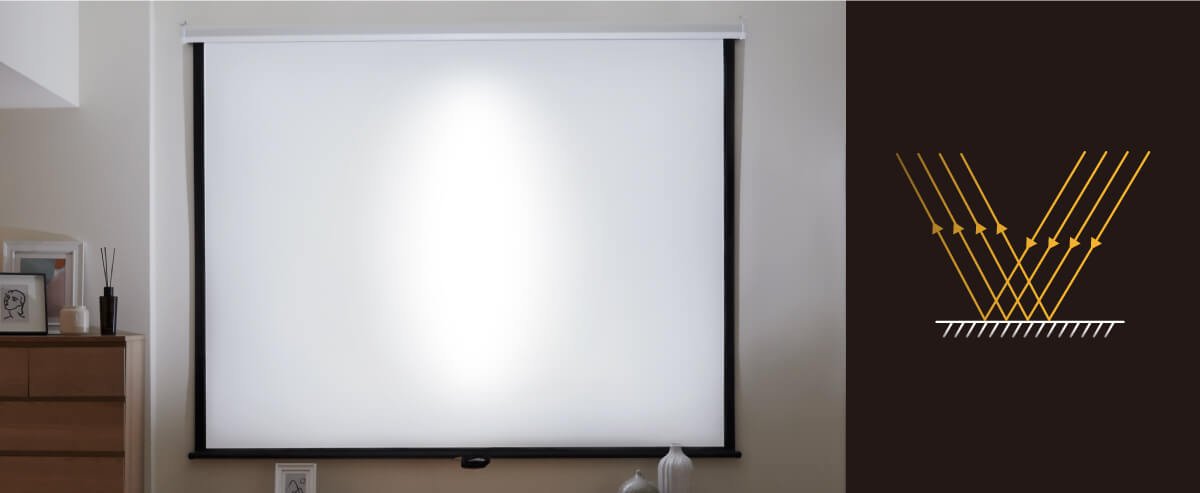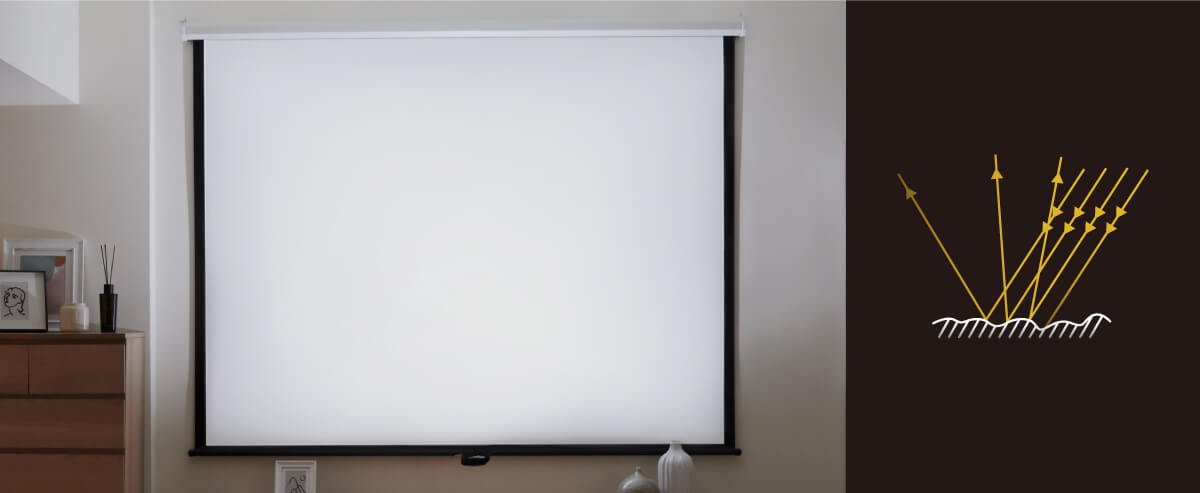Projector
Monitor
Lighting
Interactive Display | Signage
Remote Work & Learning
Choosing the right projection screen is the first step to getting the most enjoyment from your home entertainment system. Even basic entry-level projectors require a flat surface to produce the best images. Currently the range of available projection screen aspect ratios includes 4:3, 16:9, 16:10, and 2.35:1. Widescreen 16:9 and 2.35:1 formats are the most popular size/ratios for homes. This article will introduce various types of traditional projection screens as well as explain light rejecting screens and the two types of light rejecting screens, the ALR and CLR.


A type of screen requiring the user to manually pull the screen down, manual projection screens offer low cost. However, manual screens require readjustment each time they are pulled because the screen position will shift, and the screen can become curled or crimped over time.

This screen’s operation is different from a manual projection screen. The casing of the screen is placed on the floor and the screen gets pulled up into place. While it is convenient to use without any installation, this type of screen requires more space and is not aesthetically pleasing in a home setting, more suitable for outdoor or office use.

Commonly used in conference rooms and homes, electric screens automatically lower or rise to user-defined stopping points. Similar to manual projection screens, electric screens can become curled or crimped over time.

This screen type uses electronic controls and tension cords on both sides of the screen to pull the screen tightly for flatness. While this type of screen prevents curling, it is a more expensive solution.

Fixed screens can be set up to hang on a wall like a painting, offering the best flat shape of all the screens listed. These screens blend into surrounding décor for improved aesthetics, and the latest light rejecting screens also feature this type of installation method.
Even with all these options, most home theaters suffer from less-than-ideal lighting conditions (darkness with all lights off) or interference from outdoor light, and typical users find it difficult to block surrounding light from degrading projected image quality. With this in mind, the light rejecting screen - uniquely designed to combat ambient light - can provide superb image quality in home theaters, classrooms, or conference rooms without turning the lights off for comfortable viewing.

Lights on

Lights off
A light rejecting screen features special optical technology comprised of embedded black and white linear Fresnel lenses, whose black portions absorb ambient light while white elements reflect projected light directly to the viewer. This optical technology enables light rejecting screens to be used in fully lit indoor settings, creating the clearest and most faithful images of the highest quality.
*Light rejecting screens currently allow image width up to 100" (16:9 screen ratio) using projectors with a throw ratio of 0.25 or below. To ensure the effectiveness of light rejecting technology, the projector must be installed below the screen.

Black and White Linear Fresnel Lens Structure
Traditional projection screens rely on specular reflection, which causes problems with glare and the so-called spotlight effect. To counteract these issues, light rejecting screens feature enhanced anti-glare (AG) properties which diffuse reflection to eliminate spotlighting.

Screens without anti-glare properties exhibit spotlight effects

Screens with anti-glare properties do not suffer spotlight effects
Regular projections screens also typically use flat screens or repeating optical structures, which contain major defects. Flat screens reflect much of the main projected light up towards the ceiling, causing diminished brightness and inadequate image quality, while screens with repeating optical structures result in brightness uniformity regions.

Flat Screens - main light reflected toward the ceiling

Repeating optical structures - with centrally-focused design, light from the top and bottom is uneven
With varying projection angles compounding the problems described above, a single design solution is incapable of addressing the problems of uneven brightness uniformity. Only an adaptive design can effectively deliver light to the viewer, and only light rejecting screens which employ a gradient optical structure can assure superior image quality.

Gradient Optical Structures - because the angle of incoming light varies, only an adaptive design can effectively deliver light to the viewer, which requires gradient optical structures
Ambient Light Rejection screen (ALR) is a screen that selectively reflects light back to the audience, unlike most common screens reflect the incoming light uniformly in all directions. ALR screens This effect is achieved by positioning the projector and screen in such a way that the projector's light is bounced towards the audience while the other ambient light in the room is reflected back in some other direction out of the view of the audience. ALR screens only work if the ambient light is not hitting the screen from the same direction the projector.
Ceiling Light Rejecting® (CLR) is a new version of Ambient Light Rejection screen (ALR). The special material absorbs up to 95% of overhead lighting. Its serriform optical surface lens microstructure negates the washout effect of ambient light especially from overhead sources. This also enables the material to provide contrast levels that are 100 times greater than that of standard matte white projection screens. We recommend to match BenQ's laser projectors with Aeon CLR® Series - Elite Screens Projector Screens (model name: AR100H-CLR, AR120H-CLR) .